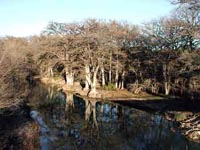Resource Library
Plant of the Week: Bald Cypress
The University of Arkansas System Division of Agriculture does not promote, support or recommend plants featured in "Plant of the Week." Please consult your local Extension office for plants suitable for your region.
Plant of the Week
Bald Cypress
Latin: Taxodium distichum

Looking out my office window every morning I enjoy the majesty of a full-grown bald cypress that demonstrates mature trees, as well as people, spread out as they get older.
Bald cypress, Taxodium distichum, is familiar to all southerners because it grows along waterways and bayous in soft, moist ground throughout the region. Its range is from Virginia into southern Illinois and Indiana, then westward to the southern hill country of Texas. It never gets far from slow moving, shallow rivers.
Bald cypress maintains a tolerance of cold and grows as far north a Maine and Michigan when used in the landscape.
Leaves of bald cypress are small and needle-like and produced in random arrangement along the small branches of the limbs. In late summer, they begin to turn brown but are not shed until after the first frost.
Young trees grow ramrod straight and form narrow pyramids that have the traditional Christmas tree shape of most young conifers. They usually top out at between 90 and 120 feet on moist ground, 60 feet on dry sites.
Bald cypress 800 to 1,200 years old, while certainly rare, are known. Because they were in inaccessible sites in the middle of a swamp, large scale commercial logging did not begin much before 1880. Before that the only trees cut, some with trunks 8 feet through, were along waterways.
But loggers soon learned that 80 percent of the bald cypress logs full of sap were "sinkers," and they ended up embedded in the mud along the side of the river. Bald cypress wood is incredibly durable and will resist decay for centuries if not exposed to oxygen. This submerged wood is now being reclaimed from southern river beds and being used for fine cabinetry.
David Stahle, a UofA geographer who studies climate change using tree ring dating methods, has used bald cypress cores from standing and submerged trees to look at the climatic record for the past 2,000 years.
In one of his most interesting studies, he demonstrated that the 116 settlers that disappeared without a trace from Roanoke Island in 1587 had the misfortune of trying to establish a new colony in the midst of the worst drought the region had experienced in 800 years.
Standing cypress is one of the best anchored trees in our native woodlands. Hurricanes along the southeastern coast will blow pines down in wide swaths, leaving the fat trunks of bald cypress jutting skyward in a tangle of destruction. This good anchorage, even though embedded in mud, is due to the tangle of roots and "knees" at the base of the trees.
Knees were once thought to be important in oxygen exchange for the roots but this notion has been discredited because researchers have cut away knees and trees have suffered no ill effects. Knees form only in water or in saturated ground, and are not present when trees grow in upland sites.
Looking at the swamps where bald cypress grow, the erroneous conclusion is often reached that they must be planted in wet sites. Bald cypress, while it needs standing water or saturated ground for seed germination, is drought tolerant once established.
Container grown trees or year old seedlings are best used when planting bald cypress in the landscape. They look most at home when planted in irregular groups of five or more such that the length of the planting is greater than the mature height of the trees. Young trees grow rapidly and usually average 2 feet or more of growth a year.
By: Gerald Klingaman, retired
Extension Horticulturist - Ornamentals
Extension News - February 8, 2002
The University of Arkansas System Division of Agriculture does not maintain lists of retail outlets where these plants can be purchased. Please check your local nursery or other retail outlets to ask about the availability of these plants for your growing area.